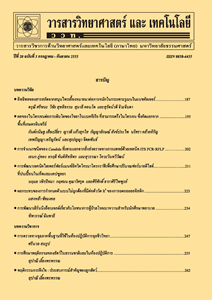การดูดซับสารประกอบฟีนอลจากสารละลายโดยชีวมวลสาหร่ายผักกาด
Main Article Content
Abstract
บทคัดย่อ
การดูดซับทางชีวภาพของสารประกอบอินทรีย์ โดยชีวมวลสาหร่าย เป็นวิธีการบำบัดน้ำเสียจากโรงงานอุตสาหกรรมที่มีประสิทธิภาพวิธีหนึ่ง ได้ศึกษาความสามารถดูดซับสารประกอบฟีนอล ได้แก่ ฟีนอล 4-คลอโรฟีนอล และ 2,4-ไดคลอโรฟีนอล โดยใช้ชีวมวลสาหร่ายผักกาด Ulva reticulata ที่พบมากบริเวณแหลมตาชี อ่าวปัตตานี โดยศึกษาระยะเวลาการดูดซับ ผลของพีเอช ปริมาณของสาหร่าย และความเข้มข้นเริ่มต้นของสารประกอบฟีนอลต่อความสามารถดูดซับสารประกอบ ฟีนอลแบบกะ พบว่าตรวจไม่พบสารประกอบฟีนอลในตัวอย่างสาหร่าย และพบว่าตัวอย่างชีวมวลสาหร่ายดูดซับสาร ประกอบฟีนอลต่างๆ ได้ดีในเวลา 120 - 180 นาที พีเอชมีผลต่อความสามารถดูดซับสารประกอบฟีนอล โดยตัวอย่างสาหร่ายการดูดซับเกิดขึ้นได้ดีที่สุดที่พีเอช 5 นอกจากนี้การดูดซับเพิ่มขึ้นเมื่อปริมาณของสาหร่ายเพิ่มขึ้นในช่วง 0.5 - 3.0 กรัม/ลิตร ข้อมูลสมดุลการดูดซับสารประกอบฟีนอลเป็นไปตามแบบจำลองของแลงค์เมียร์และฟรุนดลิช โดยตัวอย่างสาหร่ายผักกาดสามารถดูดซับฟีนอล คลอโรฟีนอล และไดคลอโรฟีนอลสูงสุด ตามแบบจำลองของแลงค์เมียร์ (Qm) เท่ากับ 4.7, 9.2 และ 17.9 มก. /กรัม ตามลำดับ และ ตามแบบจำลองฟรุนดลิช (K) เท่ากับ 0.40, 1.74 และ 4.54 มก. /กรัม ตามลำดับ
คำสำคัญ : สารประกอบฟีนอล; ชีวมวลสาหร่ายผักกาด; แบบจำลองของแลงค์เมียร์และฟรุนดลิช; คลอโรฟีนอล; ไดคลอโรฟีนอล
Abstract
Biosorption of organic compounds by algal biomass is a potential technology for treating industrial wastewater. Adsorption of phenolic compounds including phenol, 4-chlorophenol (4-CP) and 2,4-dichlorophenol (2,4-DCP) in aqueous solution by marine algal Ulva reticulata available in large quantities in Pattani Bay was investigated. The kinetic profiles, the effect of pH, the amount of algae biomass and initial concentrations of phenolic compounds on sorption of phenolic compounds by the algal biomass were examined using batch experiments. It was found that the phenol compounds were not detected in the biomass samples. The adsorption capacity of the algae samples for phenolic compounds was found to be optimum at the contact time of 120 - 180 minutes. The maximum uptake of three phenolic compounds by the algal biomass occurred at the solution pH of 5.0. In addition, the uptake capacity of the algal biomass increased as the amount of algal biomass increased from 0.5 to 3.0 g/L. The equilibrium data of phenolic compounds fitted well to the Langmuir and Freundlich isotherm models (r2 > 0.99). The maximum sorption capacity of the biomass following Langmuir isotherm (Qm) for phenol, 4-CP and 2,4-DCP were 4.7, 9.2 and 17.9 mg/g, respectively, while those derived from Freundlich isotherm (K) were 0.40, 1.74 and 4.54 mg/g, respectively.
Keywords: Biosorption; Ulva reticulata; Phenolic compounds

